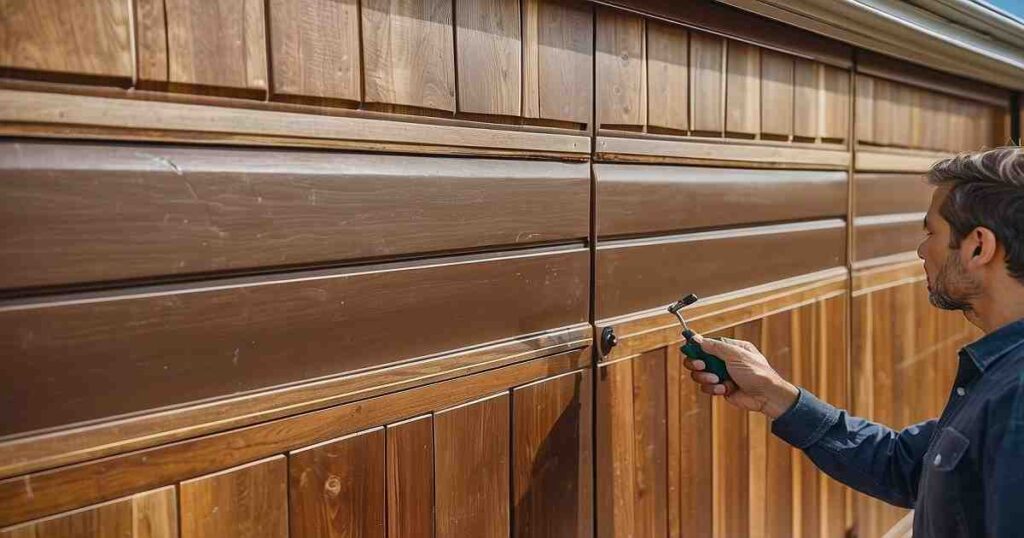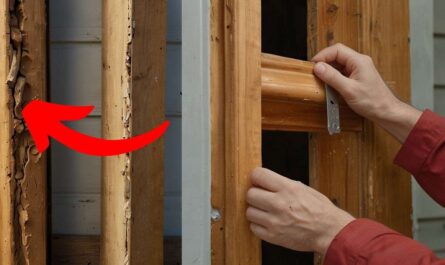Garages do more than just store cars; they also help to how your home looks from the outside. Your garage door’s paint and condition can make or break your home’s curb appeal. If you want to improve how your home looks, painting is a simple solution. In this article, we’ll walk you through how to paint a garage door look like wood, offering easy steps and useful advice to make the process smooth.

Understanding the Wood Grain Effect
Creating a wood grain effect on your garage door involves copying the natural look and texture of wood through paint. It’s a technique that can give your door the elegance and warmth of wood without the cost and maintenance of actual wood doors. Here’s a simple breakdown:

Texture Matters:
To paint a garage door to look like wood grain, the grain effect is all about recreating the texture and lines that are characteristic of wood. This is achieved by using special tools and painting techniques to create these patterns on your garage door.
Layering:
The process involves layering different shades of paint to resemble the natural variations in wood colors. Starting with a base coat, darker and lighter shades are applied to create depth and realism.
Graining Tool:
A graining tool, or similarly improvised tools also for metal doors, are used to drag through the wet paint to create the grain effect.
Sealing the Deal:
After the paint has dried and the effect is achieved, applying a clear sealant can protect your artwork and add a glossy or matte finish, reflecting your personal preference.
Tools and Materials:
Before moving to the painting process you will need the following Tools:
- Garage door paint kit (includes base coat and top coat)
- Wood graining tool
- Paint brushes
- Painter’s tape
- Drop cloth
Preparing the Garage Door Surface
Get that garage door paint to look like wood:
Clean it:

Wash off dirt and grime, and let it dry.
Sand:
Smooth out rough spots with sandpaper for perfect paint adhesion.
Repair Damages:

Fill in any dents or scratches in the garage door point with a suitable filler and sand the area again once it’s dry.
Wipe Down:
Use a tack cloth or a damp rag to wipe down the door, removing any dust or particles left from the sanding.

Tape Off Areas:
Apply painter’s tape around edges, handles, and windows to protect them from paint.
Starting Your Painting Journey
Choose Your Paint Colors:
Think of the wood door color you love. Choose a light base color, then add some dark and light shades for the grain. It’s like selecting colors for a great outfit – these colors team up to create the magic.
2. Apply the Base Coat:
Roll on your base color. This is like laying down a canvas before you start a coat of paint. Make sure it’s even and covers well; this is the foundation that your beautiful wood effect will build.

3. Mix Your Glaze:
This is where the fun begins. Mix your darker paint with a glazing medium. This mixture isn’t just ordinary paint; it’s what we’ll use to create those cool grain effects. Think of it as the special sauce in your favorite recipe.
4. Playing with Graining Tools:
After the base coat is dry, it’s time to artfully apply the glaze with a graining tool or even a simple comb. Drag it along in wavy lines to make the faux wood grain. Just like when you’re doodling or making patterns in the sand, feel free to get creative.
5. Details and Highlights:
Once your glaze is on and the grain looks just right, use a smaller brush to add lighter shades. These highlights are like adding sparkle to your eyes; they make the wood grain garage door pop and look more real.
Finishing Touches in faux wood
Once everything is dry, it’s time to seal the deal. Here are some tips for adding those finishing touches:

- Use a Good Brush: Apply the sealant smoothly with a good brush, and pay attention to the drying period between applications as directed.
- Select a Sealant: For a protective treatment that brings out the grain wood, choose a marine varnish or transparent polyurethane.
- Add Additional Coats: Depending on your desired level of protection and finish, you may need to add multiple coats of sealant.
- Sit Back and Admire: After the final coat of sealant has dried, step back and admire your beautiful faux wood garage door. Not only will it stand out and improve your home’s curb appeal, but it will also save you time and money compared to real wood doors.
FAQs:
Can garage doors be painted to look like wood?
Ans: Yes, you saw that right you can paint your garage door to look like wood With just a few simple steps your garage door and wood look brand new.
Is it better to paint or stain a new garage door?
Ans: Either stain or wood look garage door paint can be used to refinish a wood garage door. Staining is ideal for accenting the woodgrain, while painting gives you a larger range of color options and greater saturation. Both are effective finishes when it comes to protecting the faux wood finish from the elements.
What is the best stain for a garage door?
Ans: As always, make sure to use a gel stain so you’re newly stained wooden garage door will last longer and look professional. A penetrating oil-based stained wood is usually the best.
What is the best paint finish for a wood garage door?
Ans: Latex will cover but will tend to deteriorate over time. Wood: A good latex paint is best to paint a garage door to make it look like wood. Oil-based exterior paint will crack, and peeling will occur.
Conclusion
Painting your garage door to look like wood can be a fun and fulfilling project, giving your home an upgraded look without investing a huge amount. With some basic supplies, techniques, and patience, you can turn your ordinary garage door into a beautiful statement piece. So grab a paintbrush and get ready to replace your garage door using these easy-to-follow tips.



